Table of Contents
- Overview
- Editor’s Choice
- Global Sports Medicine Market Top Statistics
- Prevalence of Sports Injuries Worldwide
- Sports Medicine Most Common Injuries Statistics
- Sports-Related Injuries by Age Group
- Sports Medicine Most Common Treatments for Injury Statistics
- Top Key Players in the Sports Medicine Market Statistics
- Top Key Overuse of Sports Medicine Statistics
- Recent Developments
- Final Words
- FAQs
Overview
Sports Medicine Statistics: Sports medicine is a specialized field of healthcare that focuses on optimizing performance, and preventing, and treating injuries of athletes and physically active individuals.
It blends the expertise of medical professionals, physiotherapists, nutritionists, and trainers to enhance athletic performance, facilitate recovery, and promote overall well-being.
In this dynamic and evolving discipline, the primary goal is to keep athletes at the peak of their abilities while minimizing the risk of injuries that can sideline them.
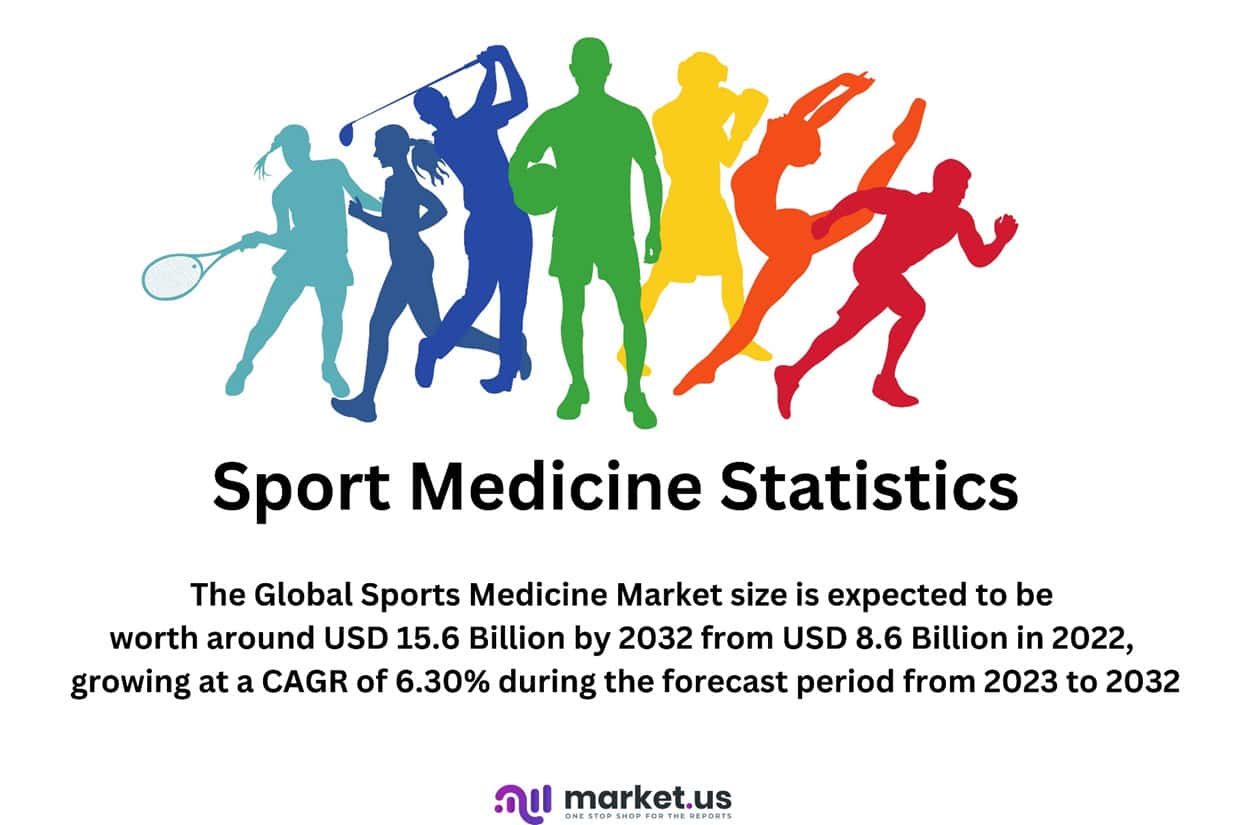
Editor’s Choice
- In the United States alone, approximately 8.6 million sports-related injuries are reported each year.
- On average, there are about 1.6 to 3.8 million sports-related concussions in the U.S. annually, with the highest incidence among high school football players.
- Youth sports play a vital role in physical activity. Over 30 million children and adolescents in the U.S. participate in organized sports, promoting fitness and health.
- Anterior Cruciate Ligament (ACL) injuries are common in sports like soccer and basketball. Female athletes are at a higher risk, with studies showing that they are 2 to 8 times more likely to sustain ACL injuries than males.
- Recent studies indicate that over 50% of sports-related injuries in pediatric sports medicine are due to overuse.
- After injury, the successful return of athletes to their sport is crucial. Approximately 90% of athletes successfully return to play after ACL reconstruction surgery.
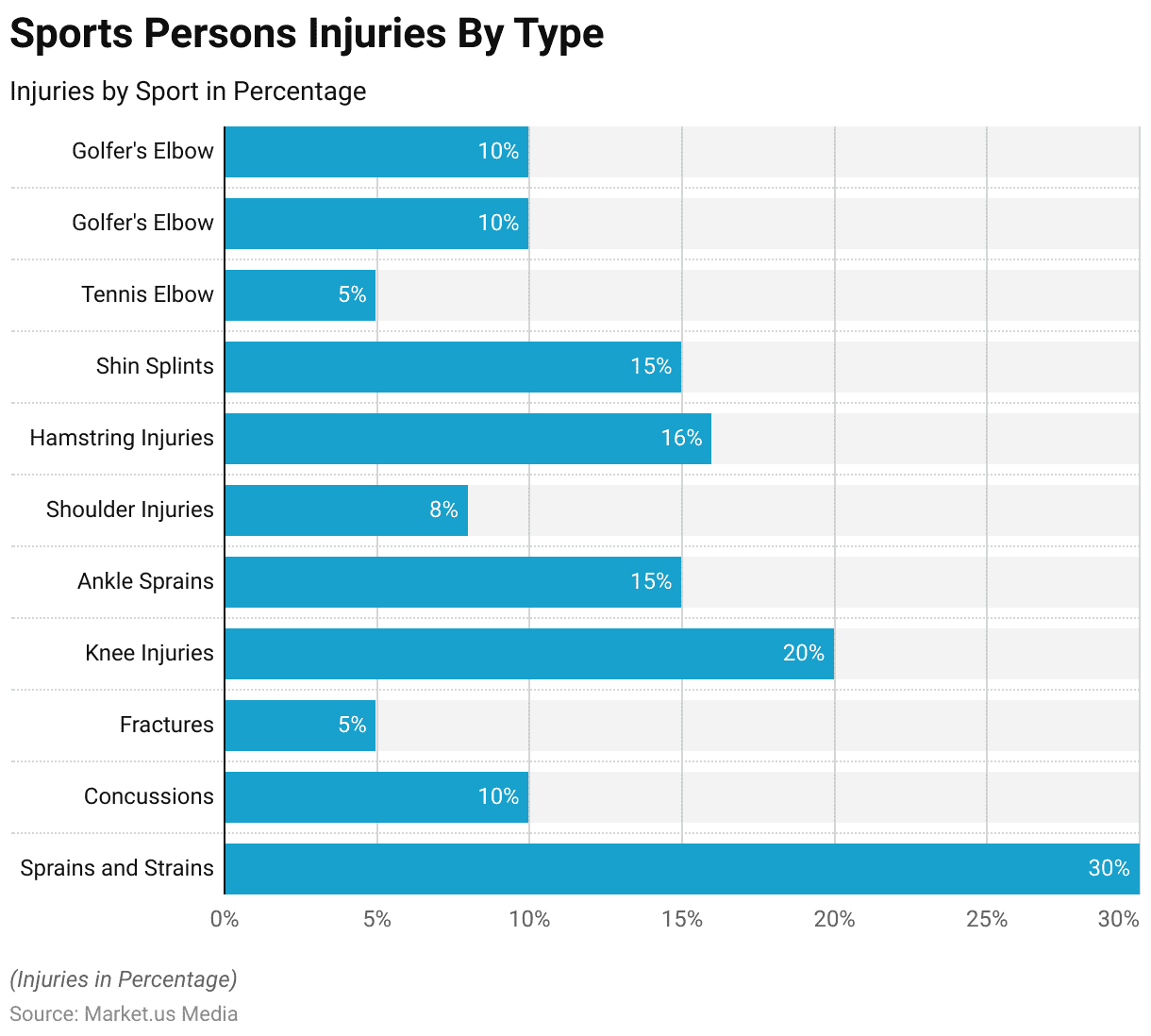
Global Sports Medicine Market Top Statistics
- The Global Sports Medicine Market size is expected to be worth around USD 15.6 Billion by 2032 from USD 8.6 Billion in 2022, growing at a CAGR of 6.30% during the forecast period from 2023 to 2032.
- In 2022, North America dominated the market for sports medication with a 37.2% revenue share. The sports medicine market is driven mainly by several factors, including a well-developed healthcare infrastructure, high spending, and the availability of technologically advanced medical devices to treat various orthopedic injuries.
- Based on product, the sports medicine market is divided into four types body support and recovery, body monitoring and evaluation, body reconstruction and repair, and accessories. Among these, the body reconstruction & repair segment dominated with the largest revenue share of 40.3% in 2022.
- Approximately 3.8 million concussions related to sports and recreational activities occur in the United States each year.
- Key players in the sports medicine market include Stryker Corporation, Johnson & Johnson, Smith & Nephew, and Medtronic, among others.
(Source: Brain Injury Research Institute, Market.us)
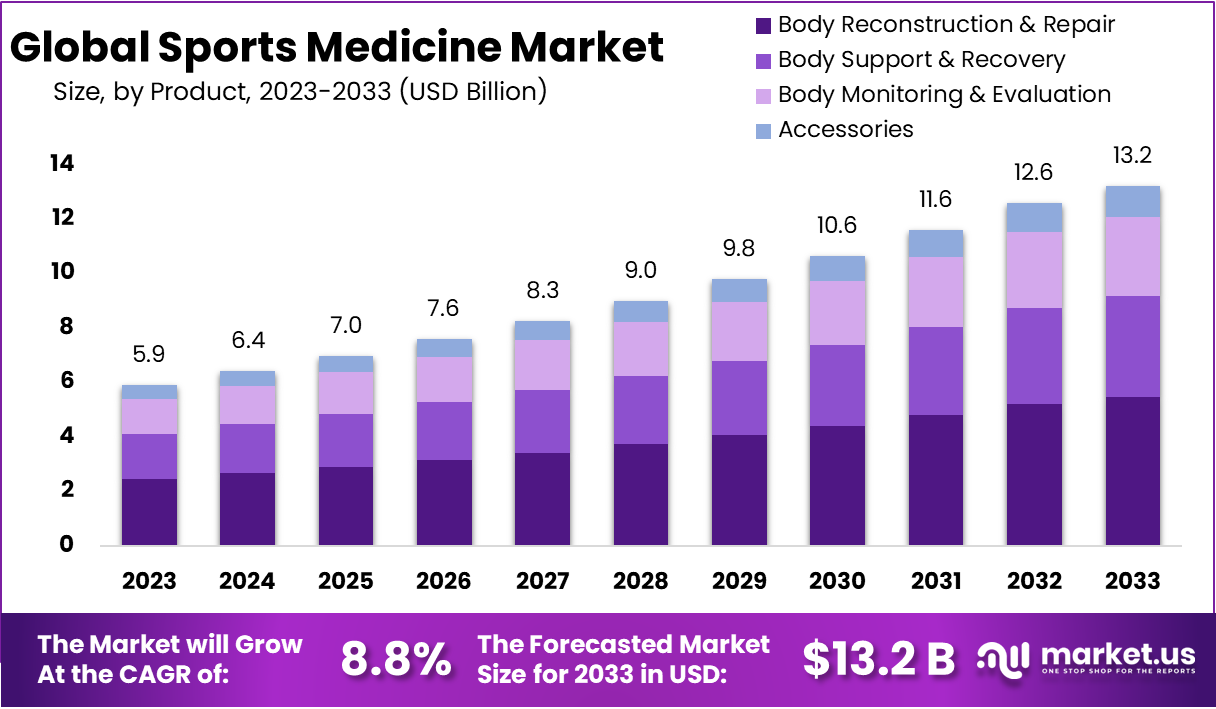
Prevalence of Sports Injuries Worldwide
- Each year, over 3.5 million children aged 14 or younger are injured while playing sports or participating in recreational activities, accounting for roughly 21% of traumatic brain injuries among American children.
- Nearly half of head injuries sustained during sports or recreational activities result from bicycling, skateboarding, or skating incidents.
- Each year over 775,000 children aged 14 or younger seek treatment in hospital emergency rooms due to sports-related injuries.
- These injuries usually stem from falls, being hit by objects, collisions, and overexertion during unorganized or informal sports activities.
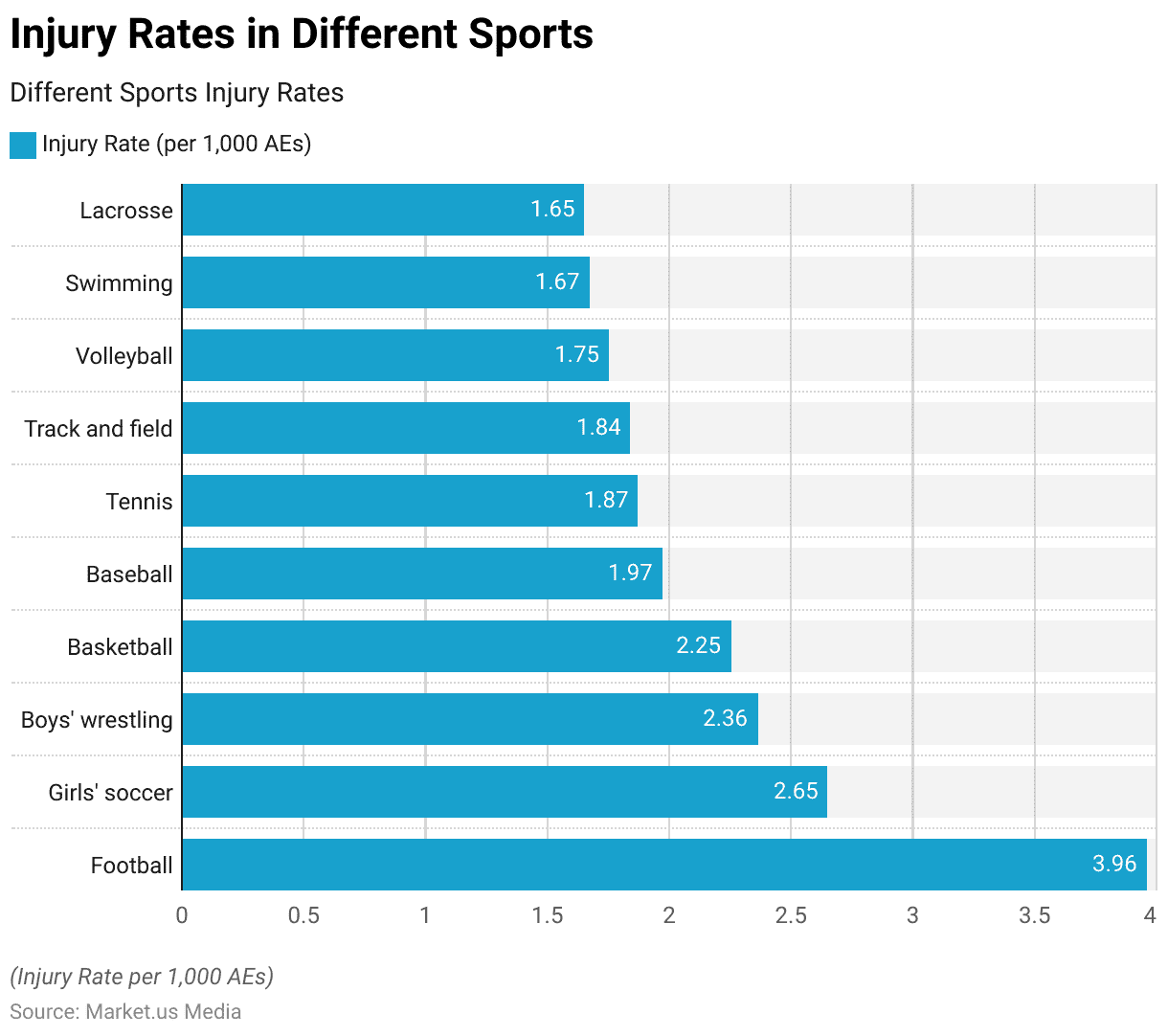
Sports Medicine Most Common Injuries Statistics
- Sprains and Strains: Approximately 30% of all sports injuries are sprains or strains.
- Concussions: Concussions account for around 10% of all sports-related injuries.
- Fractures: Fractures, particularly in the wrist, account for about 5% of sports injuries.
- Knee Injuries: Knee injuries, including ACL tears, are prevalent and constitute about 20% of all sports injuries.
- Ankle Sprains: Ankle sprains make up approximately 10-15% of sports-related injuries.
- Shoulder Injuries: Shoulder injuries, such as rotator cuff tears, account for about 8% of sports injuries.
- Hamstring Injuries: Hamstring injuries are common, with about 12-16% of all sports injuries involving the hamstrings.
- Shin Splints: Shin splints occur in about 15% of all sports injuries.
- Tennis Elbow: Tennis elbow affects approximately 5% of athletes, not limited to tennis players.
- Golfer’s Elbow: Golfer’s elbow occurs in roughly 7-10% of all sports injuries.
(Source: Centers for Disease Control and Prevention, American College of Sports Medicine)
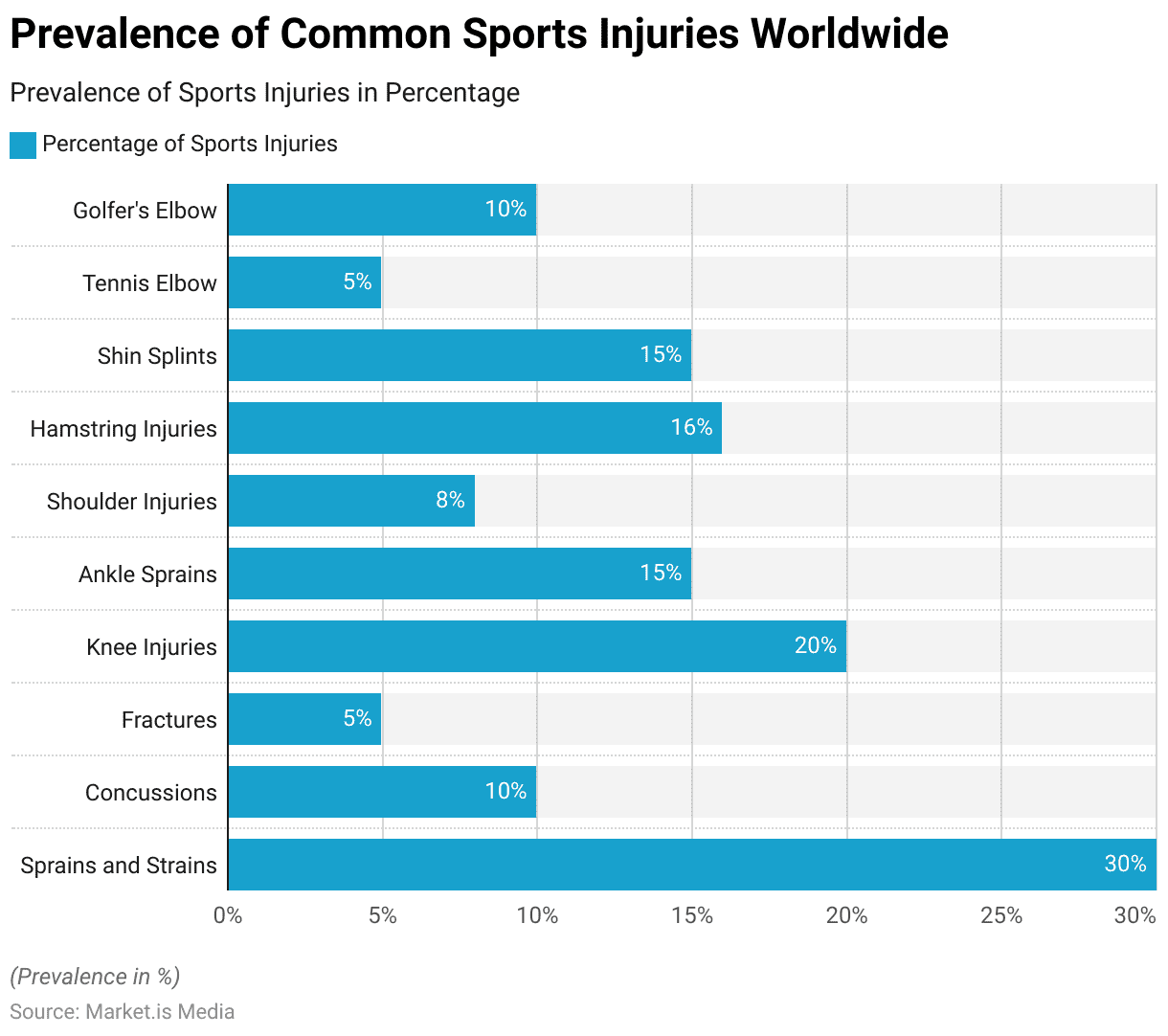
Sports-Related Injuries by Age Group
Children and Adolescents (Ages 5-18)
- In the United States, approximately 2.6 million children and adolescents suffer sports-related injuries annually. These injuries led to over 775,000 emergency room visits.
- The most common sports injuries in this age group are sprains and strains, followed by fractures and contusions.
- Concussions account for a significant portion of sports-related injuries among young athletes, with an estimated 1.1 to 1.9 million cases annually.
(Source: CDC, Safe Kids Worldwide, American Academy of Pediatrics)
Young Adults (Ages 18-30)
- Among college athletes, the annual injury rate is approximately 9.2 injuries per 1,000 athlete exposures.
- Overuse injuries, such as tendinitis and stress fractures, are common in young adult athletes, accounting for a substantial portion of injuries in this age group.
- About 30% of young adults who participate in organized sports report experiencing an injury that required medical attention or restricted their activities for more than three days. (Source:)
(Source: NCAA, NSC)
Take advantage of our unbeatable offer - buy now!

Adults (Ages 30-65)
- In adults aged 45-64, sports and recreation-related injuries led to approximately 1.3 million emergency room visits in the United States in a recent year.
- Among adults, the most prevalent sports-related injuries include joint sprains, muscle strains, and back injuries.
- Regular physical activity can reduce the risk of chronic diseases in this age group, including heart disease and type 2 diabetes.
(Source: CDC, Mayo Clinic, WHO)
Seniors (Ages 65+)
- Falls during sports or recreational activities are a significant concern for seniors. In the U.S., falls among older adults result in more than 2.8 million injuries treated in emergency departments annually.
- Senior athletes who engage in activities like swimming, cycling, and yoga tend to have fewer injuries compared to high-impact sports.
- Proper warm-up and stretching routines can help reduce the risk of injuries in older athletes.
(Source: CDC, American Academy of Orthopaedic Surgeons)
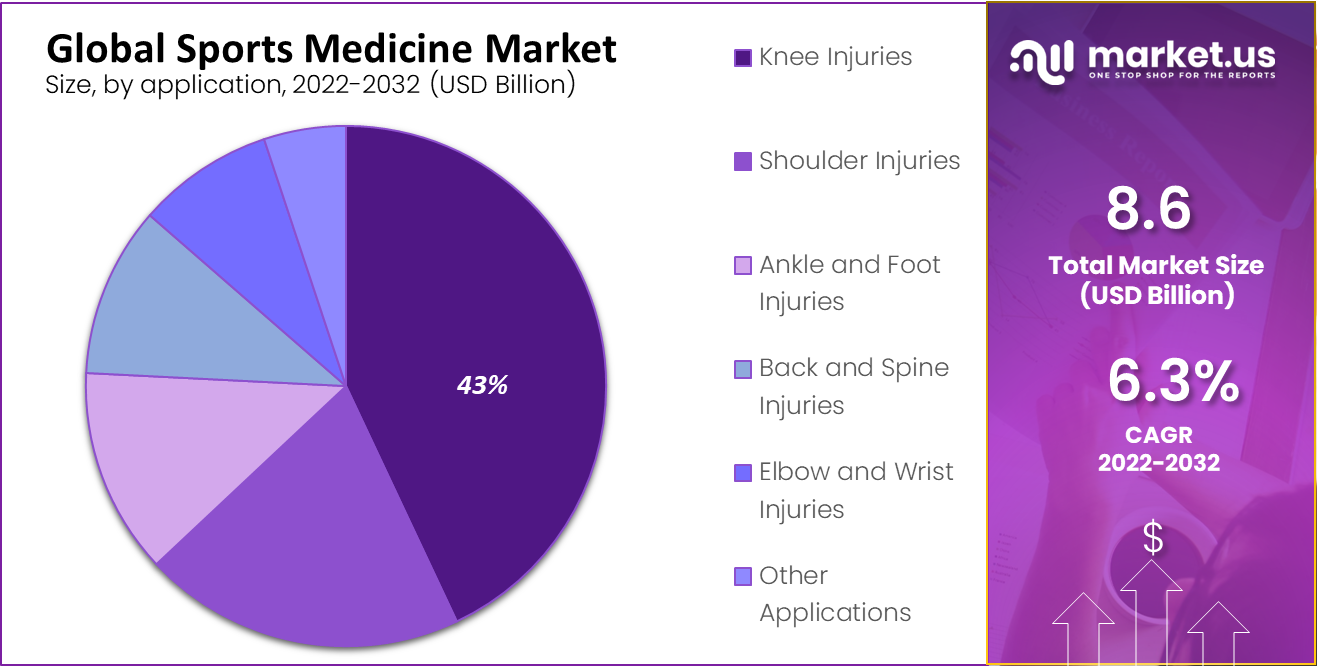
Sports Medicine Most Common Treatments for Injury Statistics
Non-steroidal anti-inflammatory Drugs (NSAIDs) Usage
- NSAIDs are commonly used to manage pain and inflammation in sports injuries.
- Over 30 million Americans use NSAIDs daily for pain relief.
(Source: American Gastroenterological Association)
Corticosteroid Injections
- Corticosteroid injections are used to reduce inflammation in conditions like tendonitis.
- Approximately 10 million corticosteroid injections are administered in the United States each year.
(Source: The Journal of Bone & Joint Surgery)
Opioid Pain Medication Use
- Opioid medications are sometimes prescribed for severe pain in sports injuries.
- In 2020, over 50,000 overdose deaths were attributed to opioids in the United States.
(Source: Centers for Disease Control and Prevention)
Platelet-Rich Plasma (PRP) Therapy
- PRP therapy is gaining popularity for treating sports injuries.
- Over 30,000 PRP procedures were performed in the United States in 2019.
(Source: American Academy of Orthopaedic Surgeons)
Hyaluronic Acid Injections
- Hyaluronic acid injections are used for knee osteoarthritis and joint injuries.
- In 2019, approximately 1.6 million hyaluronic acid injections were administered in the United States.
(Source: Journal of the American Academy of Orthopaedic Surgeons)
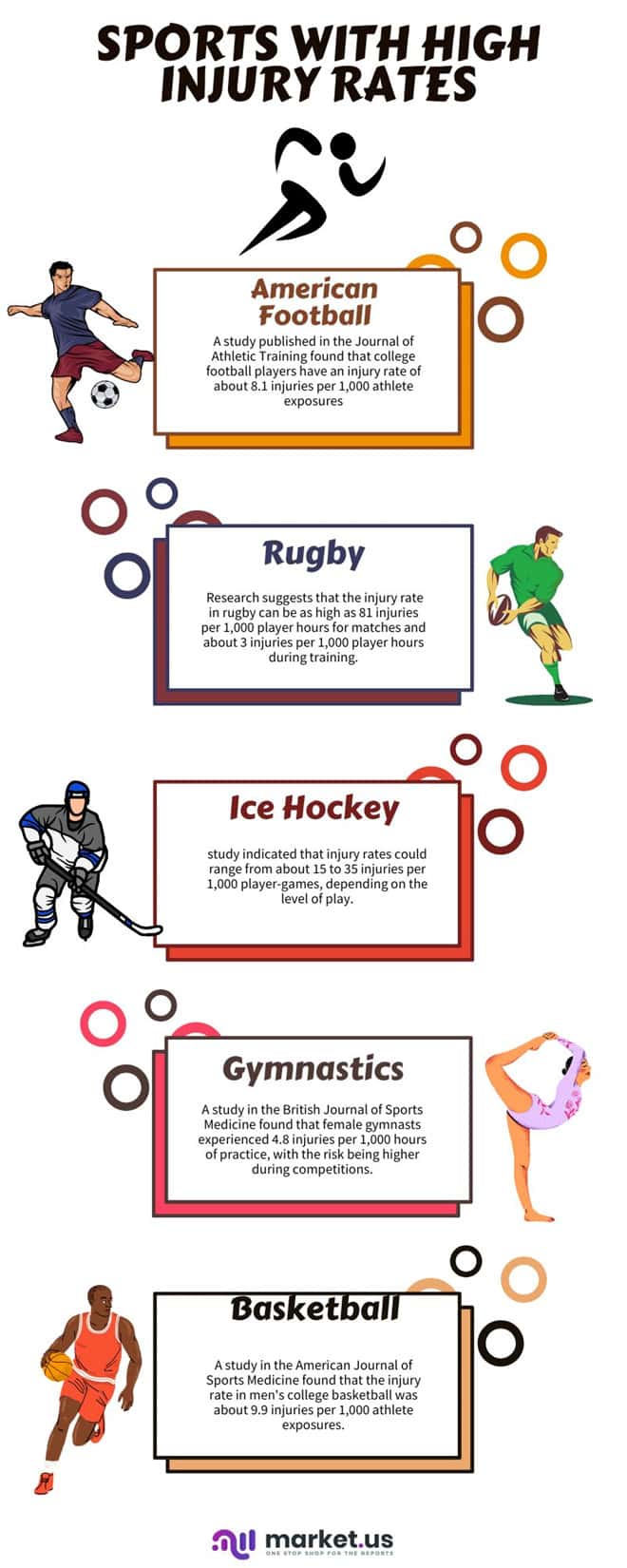
Top Key Players in the Sports Medicine Market Statistics
Arthrex, Inc.
- Arthrex is a leading player in the sports medicine market, specializing in orthopedic surgical products.
- In 2022, Arthrex reported annual revenue of over $2.6 billion.
(Source: Arthrex)
Smith & Nephew plc
- Smith & Nephew is a global medical technology company that offers a range of sports medicine and orthopedic products.
- In 2022, Smith & Nephew reported annual revenue of approximately $5.2 billion.
(Source: Smith & Nephew)
Stryker Corporation
- Stryker is a prominent player in the medical technology industry, including sports medicine solutions.
- In 2022, Stryker reported annual revenue of over $18.4 billion.
(Source: Stryker)
Johnson & Johnson (DePuy Synthes)
- DePuy Synthes, a subsidiary of Johnson & Johnson, offers a wide range of orthopedic and sports medicine products.
- Johnson & Johnson reported total sales of approximately $94.9 billion in 2022.
(Source: Johnson & Johnson)
Zimmer Biomet Holdings, Inc.
- Zimmer Biomet is known for its orthopedic and musculoskeletal healthcare products, including those in the sports medicine sector.
- In 2022, Zimmer Biomet reported annual revenue of approximately $6.9 billion.
(Source: Zimmer Biomet)
Medtronic plc
- Medtronic offers various medical technologies, including products used in sports medicine procedures.
- Medtronic reported a total revenue of approximately $31.6 billion in 2022.
(Source: Medtronic)
CONMED Corporation
- CONMED provides surgical equipment and devices, including those used in sports medicine procedures.
- In 2022, CONMED reported annual revenue of around $1.0 billion.
(Source: CONMED)
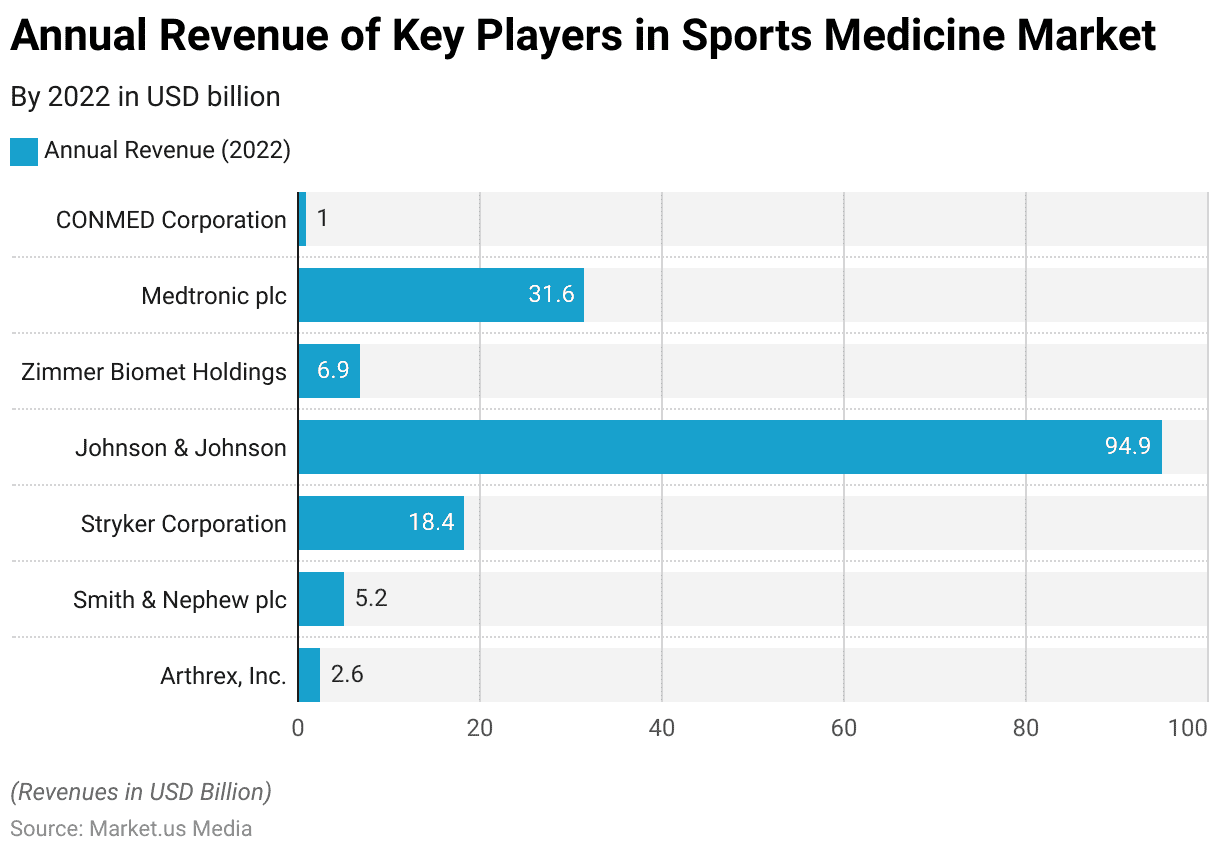
Top Key Overuse of Sports Medicine Statistics
- Usage of Performance-Enhancing Drugs: Approximately 6.4% of athletes have admitted to using performance-enhancing drugs at least once in their careers.
- Impact of Blood Doping: Blood doping can increase an athlete’s oxygen-carrying capacity by up to 10%, leading to a 10-15% improvement in endurance performance.
- Ergogenic Aids Among Athletes: Over 90% of elite athletes report using some form of ergogenic aid, ranging from legal supplements to banned substances.
- Testosterone Replacement Therapy (TRT) Use: The prevalence of athletes using TRT has risen by 500% over the past decade, raising concerns about its abuse in sports.
- Impact of Beta-Alanine: Beta-alanine supplementation has been shown to increase muscle carnosine levels by up to 80%, leading to improved high-intensity exercise performance.
- Influence of Caffeine: Caffeine intake before exercise can improve endurance performance by 12-15%, making it one of the most widely used legal ergogenic aids.
- Genetic Enhancement: An estimated 5-10% of elite athletes are believed to have genetic variations that provide a performance advantage, such as increased muscle growth or oxygen utilization.
- Use of Erythropoietin (EPO): EPO, a hormone that stimulates red blood cell production, has been involved in doping cases; it can boost an athlete’s endurance by 20% or more.
- Impact of Altitude Training: Athletes who engage in altitude training can experience a 1-2% increase in performance at sea level due to enhanced oxygen-carrying capacity.
- Age and Performance: Statistically, athletes typically reach their peak performance in their mid-20s to early 30s, with a gradual decline thereafter.
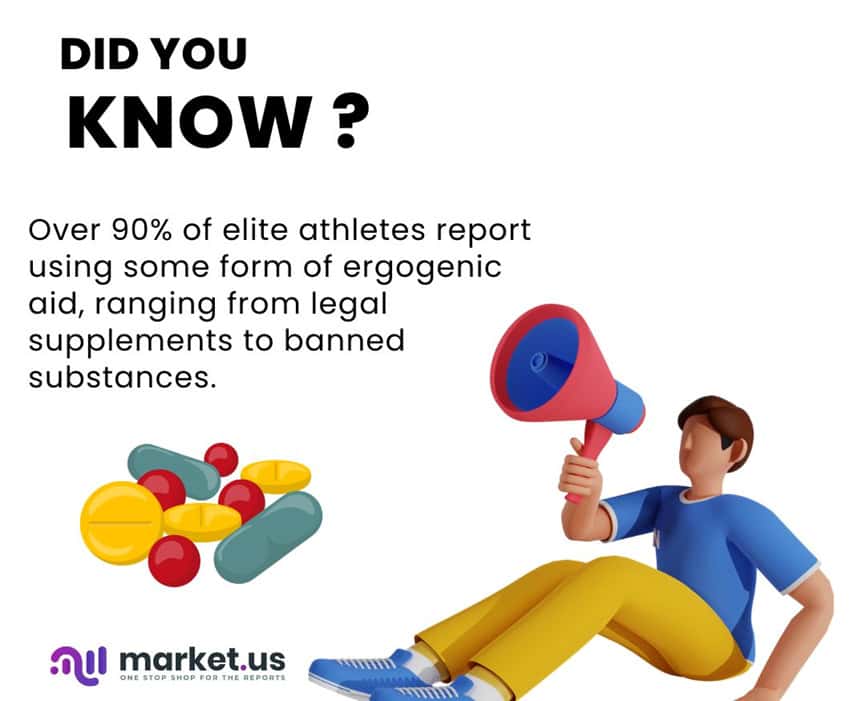
Recent Developments
Acquisitions and Mergers:
- Acquisition of a leading sports medicine clinic chain by a healthcare conglomerate in September 2023, expanding its presence in the sports medicine market.
- The merger between two prominent sports medicine equipment manufacturers in December 2023, created a comprehensive portfolio of products for athletes and healthcare professionals.
New Product Launches:
- Introduction of advanced wearable devices for athlete monitoring and injury prevention by sports technology companies in January 2024, offering real-time insights into performance metrics and injury risks.
- Launch of regenerative medicine treatments for sports injuries, such as platelet-rich plasma (PRP) therapy and stem cell injections, by medical device companies in March 2024.
Funding Rounds:
- Series C funding round for a sports medicine research institute in February 2024, raising $50 million to support clinical trials and research initiatives aimed at advancing sports injury treatment and prevention.
- Seed funding for a sports rehabilitation startup in April 2024, securing $10 million to develop innovative rehabilitation protocols and expand their network of clinics.
Partnerships and Collaborations:
- Collaboration between a sports medicine clinic and a professional sports team in November 2023 to provide comprehensive medical care and performance optimization services to athletes.
- A partnership between a sports technology company and a fitness app developer in March 2024 to integrate sports performance tracking features into the app, enabling users to monitor their workouts and progress.
Technological Innovations:
- Advancements in minimally invasive surgical techniques, such as arthroscopic surgery and robotic-assisted procedures, are improving outcomes and reducing recovery times for athletes with sports injuries.
- Integration of artificial intelligence (AI) and machine learning algorithms into sports medicine diagnostics and treatment planning, enabling personalized care and predictive analytics for injury risk assessment.
Investment Landscape:
- Venture capital investments in sports medicine startups totaled $3.2 billion in 2023, with a focus on companies offering innovative solutions for injury rehabilitation, performance enhancement, and regenerative medicine.
- Strategic acquisitions and partnerships between sports equipment manufacturers, healthcare providers, and technology companies accounted for 50% of total investment activity in the sports medicine market in 2023, reflecting industry collaboration and efforts to address the evolving needs of athletes and sports enthusiasts.
Final Words
Sports Medicine Statistics – Sports medicine plays a pivotal role in enhancing athlete performance, preventing injuries, and ensuring the overall health and well-being of individuals engaged in sports and physical activities.
With the constant evolution of medical science, technology, and data-driven approaches, the future of sports medicine holds tremendous promise.
Athletes and sports enthusiasts can look forward to safer and more effective training regimens, personalized injury prevention strategies, and improved recovery methods.
As sports medicine continues to advance, it reinforces the idea that the pursuit of athletic excellence can coexist with the preservation of athlete health and longevity.
FAQs
The most common sports injuries include sprains and strains, fractures, dislocations, and knee injuries. Among these, ankle sprains, hamstring strains, and anterior cruciate ligament (ACL) tears are often cited as being particularly prevalent.
Children and adolescents are more likely to experience sports injuries than adults. This is because their bones and muscles are still developing and they may not have the same level of coordination and strength as adults.
Contact sports like American football, rugby, and ice hockey often have higher rates of injury compared to non-contact sports.
Discuss your needs with our analyst
Please share your requirements with more details so our analyst can check if they can solve your problem(s)



